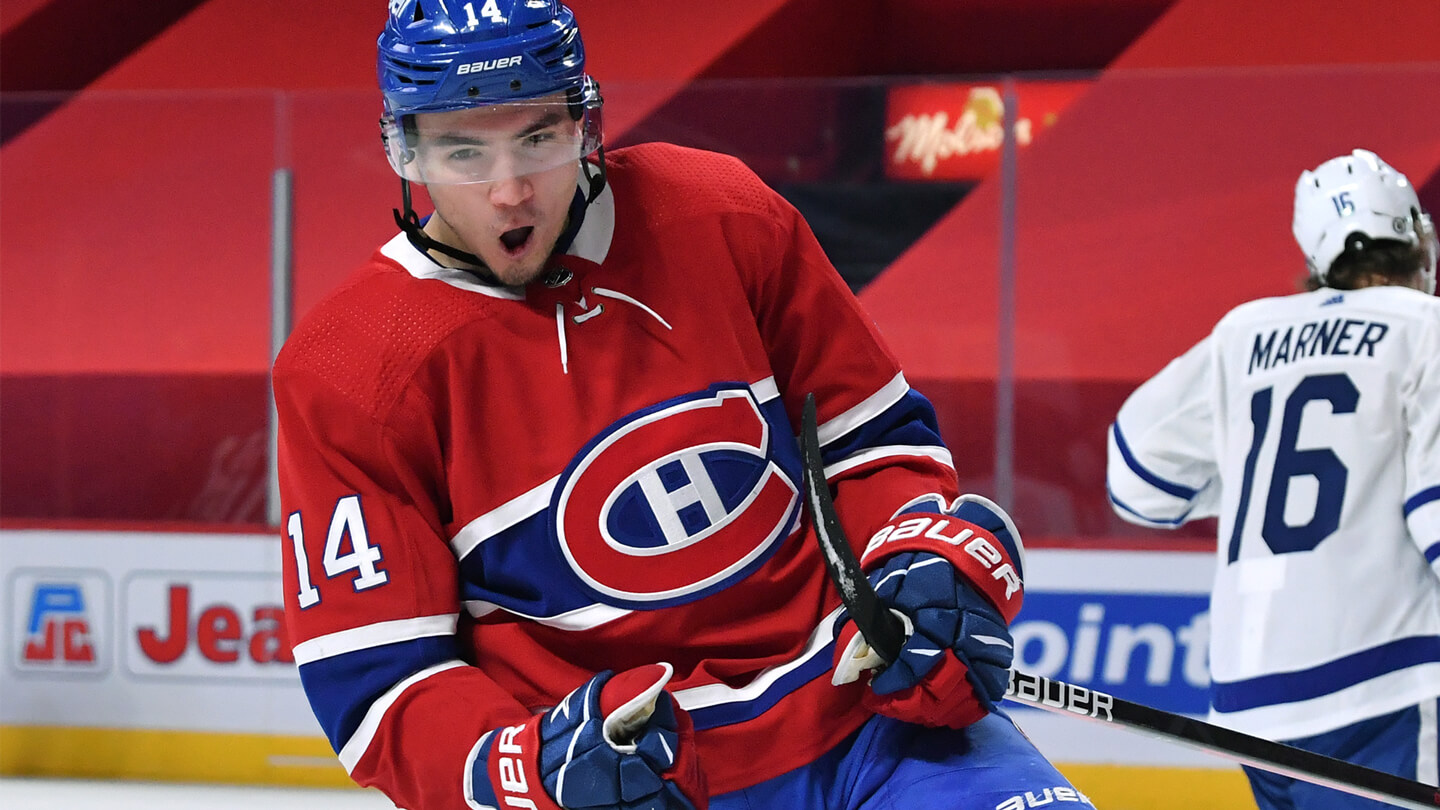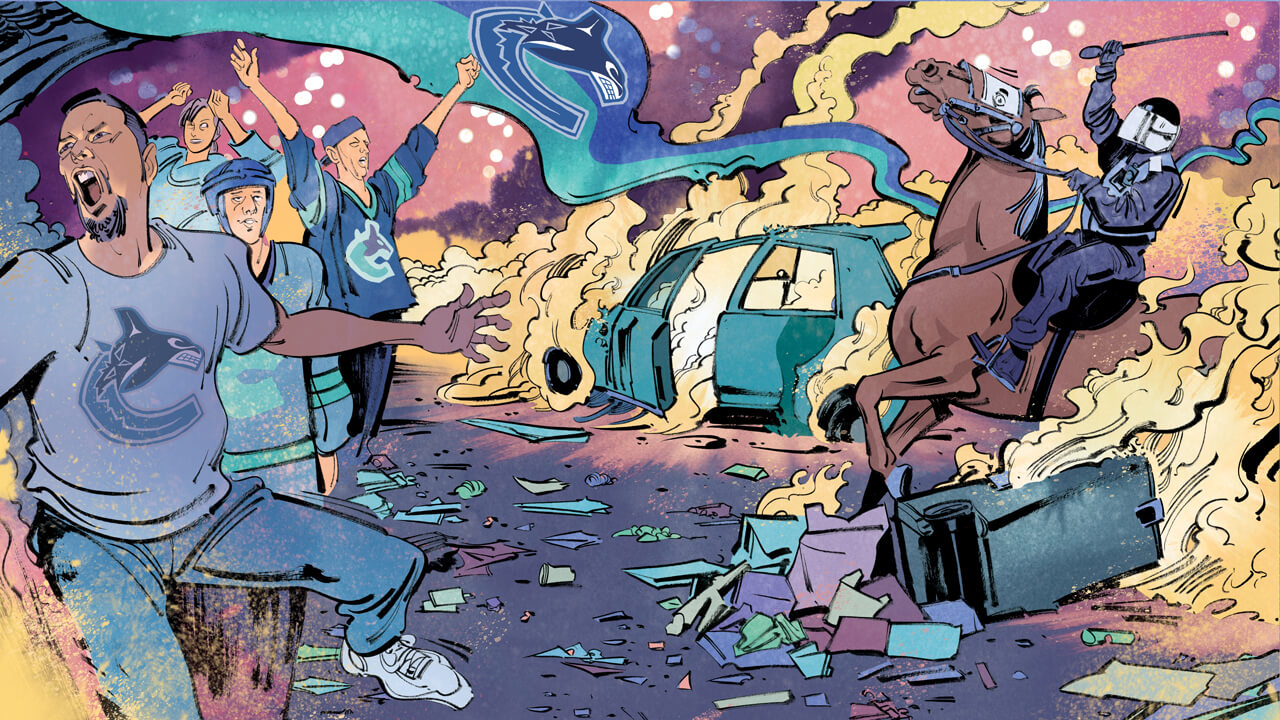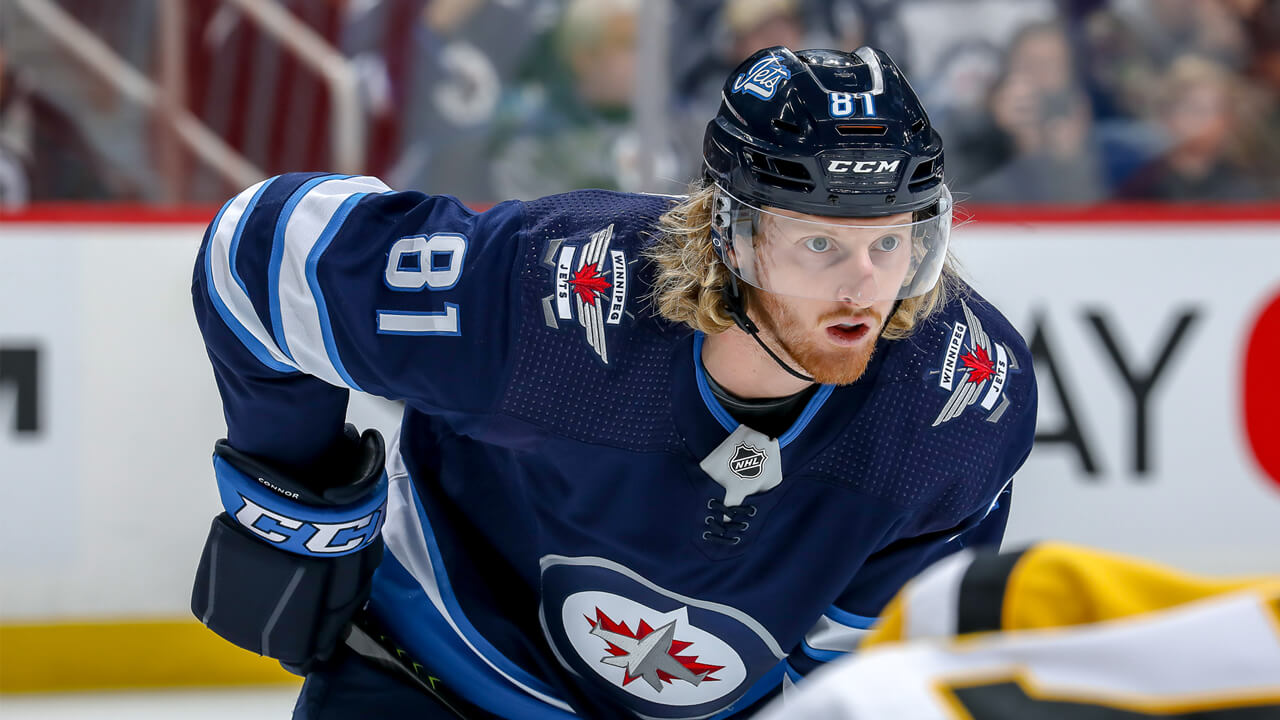It’s the first period of the first game. The Montreal Canadiens jumped all over the Winnipeg Jets to start their second-round series, but an early 2–0 Habs advantage has been cut in half by an Adam Lowry shortie. The vising Canadiens would surely be happy taking a lead into the first intermission, but — all things considered — the Jets probably feel okay, too, having recovered a bit after stumbling out of the gate.
The frame is less than three minutes from ending when Nick Suzuki gets control of the puck deep in the Habs’ zone and shovels it over to linemate Cole Caufield before getting pinned to the boards by Jets captain Blake Wheeler. One pass later, Montreal defenceman Joel Edmundson is weighing his options for an outlet and spots Suzuki — switching to attack mode — gusting up the left side of the ice. Edmundson banks the puck off the boards right in front of the Jets bench and Suzuki takes it on his forehand with his back to the play, pivots and streaks over the Winnipeg blue line on a quick-developing 2-on-1 with Tyler Toffoli. Using the threat of a pass to paralyze Jets defenceman Derek Forbort, Suzuki loads his stick like he’s about to release, then sucks the puck back, traces the outstretched pad of goalie Connor Hellebuyck and stuffs it in the open cage while whizzing past the net. Game 1 ends 5–3 in favour of Montreal.
Five days later, Suzuki is playing in what Habs fans hope is the final period of the final contest. A Montreal goal in overtime of Game 4 would give the Canadiens their second series victory in a week and put the North Division’s weakest playoff team by regular-season record into the NHL’s Final Four; a tally by the Jets sends the series back to Winnipeg and opens the door to funny business.
With the stakes understood, Suzuki, Caufield and Toffoli take their first extra-time shift. A clearing attempt by Hellebuyck is easily picked by Suzuki on the half-wall and he tries to hit Toffoli — camped out to the goalie’s right — with a pass through the red meat of the Jets’ zone. The attempt kicks off the skate of blue-liner Tucker Poolman and bounces to the corner. Suzuki tracks it, taking a pair of two-handed cuts at the puck and an additional desperation poke, trying to prevent the burly Poolman from wresting control. It works. The scrambled play gives Caufield time to arrive, juke another defender and whip the puck over to Toffoli, still lurking around the net. When Toffoli one-times Caufield’s heated dish, the Bell Centre bursts with all the joy 2,500 fans — and one elated team — can muster. Win secured, worries over and a palpable “What’s next!?” excitement enveloping the team, to say nothing of the young centre who played a key role in crucial goals that bookended the series.
The Canadiens — who head home for Game 3 tied 1-1 with the Vegas Golden Knights — are in the semifinal for just the third time since winning the 1993 Stanley Cup, following a shocking trip there in 2010 and another underdog showing in 2014. A huge reason for the club so frequently finding itself outside the NHL’s top tier has been the seemingly unending search for elite play at the centre position. That’s why, even if this Final Four appearance ends in disappointment — as the previous two runs did — there is more for Montreal to hang its hat on this time out thanks to the ongoing emergence of Suzuki. The 21-year-old who can make big plays, little plays and everything in between is proving he’s equipped to handle all that’s expected of a 1C. And while you’re not likely to hear much in the way of declarations from the man himself, Suzuki has no less faith in his abilities than the most optimistic soul singing “Olé, Olé, Olé!”

George Burnett sent a note to Suzuki saying, “You’re getting good at this come-from-behind stuff,” after Montreal ripped off wins in Games 5, 6 and 7 to eliminate the Toronto Maple Leafs a few weeks back. “He kinda chuckled [via text], as he normally would,” says Burnett, who coached Suzuki on the 2019 Guelph Storm club that climbed out of three 0–2 series holes — including one that got to 0–3 — en route to winning the Ontario Hockey League championship.
The comeback versus Toronto started in Game 5, when Suzuki played triggerman on an overtime 2-on-0 with Caufield. Sitting on the Habs bench with a headset on for the post-game interview, Suzuki wasn’t exactly coming out of his skin when he placidly described what had just transpired. “It was a great read by Cole,” he said. “I just saw we had a 2-on-0, so I just tried to get up fast. And, uh, yeah; nice bury.”
While you might expect a little more zip from someone who just netted the biggest goal of his life, coming through when it counts is nothing new for this guy. Last summer’s bubble playoffs more or less served as Suzuki’s coming out party at the highest level, and demonstrated why Montreal viewed him as the critical piece returning in the trade package received from Vegas for former Habs captain Max Pacioretty in 2018. Suzuki scored his first post-season goal in his first playoff contest, sending a perfect shot over the glove hand of Pittsburgh Penguins goalie Matt Murray. There’s also no chance Guelph would have found a way to come back in all those OHL series if not for Suzuki’s absurd, league-best 42 points in 24 playoff games. And earlier this year, as the Habs struggled during the final six weeks of the season, Suzuki did more than his part for his injury-ravaged team by leading the club in scoring with 21 points in his final 23 contests. The only other Montreal forward who had more than eight points over that time was Toffoli. “You look at our regular season at the end of the year, we were going through a tough time. You needed someone to step up and take charge, and it was him,” says Canadiens winger Brendan Gallagher. “Last year in the playoffs, same thing. He’s a guy who steps up, scores big goals. It’s something he’s done as long as he’s been playing hockey, something not everyone has.”
Few people are better positioned to talk about what Suzuki possesses than Isaac Ratcliffe, who was his linemate with the Storm and Guelph’s captain. The two grew up about a two-minute walk from each other in the London, Ont., neighbourhood of Byron. Ratcliffe and Suzuki began playing hockey together around the time they were eight years old. In the summer, it was golf and soccer, with Nick’s dad, Rob, coaching them on the pitch. Nick was a control-the-chess-board midfielder who could set up or score goals. Whether on grass or ice, he was always a move ahead. “We laugh about it still,” says Ratcliffe, a 2017 second-round pick of the Philadelphia Flyers. “When we were back in minor hockey, he was doing the exact same things that he’s doing now.”

Suzuki’s intelligent, economical approach to his craft is in line with his serene demeanour away from the rink. Ratfcliffe says the entire Suzuki crew — including Nick’s mom, Amanda, and his brother, Carolina Hurricanes 2019 first-rounder, Ryan — are kind, generous and reserved. When Nick arrived in Owen Sound as an OHL rookie, the Attack dressing room soon warmed to their new shy, sneaky-funny teammate who at least partially emerged from his shell over time on the tight-knit squad. “‘Zuks’ would sneak in there and get a laugh out of the boys,” says Michael McNiven, a former Attack goalie who’s spent the professional part of his career as a member of the Canadiens organization. “He’s always been a good, quiet kid and he’s always been a good friend of mine.”
Kevin Hancock was Suzuki’s linemate for much of their time together in Owen Sound, before both were traded to contenders later in their OHL career. Hancock is still frequently in touch with his buddy, often in regard to the fantasy football and basketball leagues Suzuki is passionate about. When he watches Suzuki now, Hancock — who spent this past season with the AHL’s Tucson Roadrunners — is struck by one particular element of his old teammate’s game. “His stickwork,” Hancock says. “His use of his stick to pick-pocket elite defencemen in the corner and be able to turn that to offence or intercept passes through the neutral zone. His skill with his stick is [a big] asset.”
Combine a quiet nature with a game that is more in-the-bone quality than leap-off-the-screen filthy, and you open the door to people underestimating or misreading Suzuki. Don’t be fooled by the lack of chest-thumping, though; to a man, those who played with him or have been in his hockey orbit describe No. 14 as supremely confident and hungry for success. “I think he’s got [an overlooked] compete level, a lot of people don’t see how determined he is,” says Burnett. “I see him battling in the NHL playoffs now, going to the corners [and] winning puck battles against some pretty big, dominant defenceman, coming up with loose pucks that ultimately end up creating scoring chances or goals.”
None bigger than the series-ender versus Winnipeg.

As linear as Suzuki’s development has been, the Canadiens’ journey to find a player of his ilk at this vital position has been more than a little circuitous. Believe it or not, Suzuki isn’t even the first centre drafted 13th overall Montreal has acquired as a prospect from another organization and pinned high hopes on. That distinction goes to Lars Eller, who was shipped to the Canadiens by St. Louis for goalie Jaroslav Halak just weeks after Halak’s brilliance propelled the Habs into the 2010 Eastern Conference Final, where they were easily dispatched by the Flyers. Eller was a bull of a player who wound up having a terrific spring when Montreal made the Final Four in 2014 and lost to the New York Rangers. Unfortunately, he never became a consistent offensive threat and was traded to Washington in 2016, winning the Cup a couple of years later in a third-line role he was perfectly suited for.
Scott Gomez was a first-year Hab when he had 14 points during the 19-game 2010 run, but that was the apex of his time in Montreal. His hefty contract eventually became so much of a hinderance that GM Marc Bergevin used a compliance buyout to cut him loose. Alex Galchenyuk was drafted third overall in 2012 to be the scoring centre of the future. Instead, two different coaching regimes believed his defensive deficiencies required hiding him on the wing and he was eventually traded to Arizona for Max Domi, who had one good year as a centre in Quebec, followed by a down season that saw him get punted to the fourth line and, ultimately, traded to Columbus.
Tomas Plekanec and David Desharnais were supposed to be the offence-driving pivots on the 2014 Final Four club, but they finished eighth and ninth, respectively, in team scoring during that post-season. Repeating the pattern from earlier in the decade, the Canadiens sank in the standings following their East Final showing in ’14 and — 24 months later — were drafting high again in 2016. They took defenceman Mikhail Sergachev, who was traded one year later for Jonathan Drouin on the premise Drouin — still only 22 years old — could come in, shift from wing to centre and become the long-sought solution down the middle. As it turned out, Drouin couldn’t have been more miscast at centre if he was Tom Hanks playing Tony Soprano. As such, come the 2018 Draft, Montreal was back picking third overall and opted for, you guessed it, a centre, taking Finn Jesperi Kotkaniemi. Four months later — on the eve of training camp — an organization now throwing around the term “reset” to describe its one-step-back approach acquired Suzuki ahead of his final major junior campaign.
Kotkaniemi — who was scratched for the first game of the 2021 playoffs — has had his ups and downs, but his big frame, strong shot and determination to improve offer some hope for his future. Phillip Danault — who can leave as a free agent this summer — has proven himself to be one of the best defensive centres in the league, but high-end offence is never going to be his calling card. Suffice it to say, then, if the Canadiens are to avoid a regression similar to the ones experienced after previous playoff successes, a lot rests on the shoulders of Suzuki, who sometimes draws comparisons to Boston’s do-it-all captain, Patrice Bergeron.
One scout for a North Division team says he believes it’s absolutely legit to connect the two, though that’s a big leap for some given Bergeron’s accomplishments. However, before he was all-caps BERGERON — the guy who can play right wing with Sidney Crosby on Team Canada; the player whose offensive production went to another level in his early 30s when he was suddenly in the middle of the best line in hockey — Bergeron was rarely spoken about in superstar terms. Rather, he was simply considered a really, really good player. Suzuki, who admired Bergeron enough to wear the latter’s No. 37 in Owen Sound, is certainly in a similar mould. “Is he the fastest guy on the ice?” asks an OHL executive who’s been watching Suzuki since his AAA days. “He’s fast, but he doesn’t look it. Is he the biggest guy on the ice? No. Is he the most talented guy on the ice? Well, he doesn’t show it, because it’s all hockey sense. He’s not toe-drag, dipsy-doodle through three guys because he knows, ‘I can make the exact same thing happen by changing the angle just a little bit, finding the passing lane through [the defender’s] stick and getting the puck on that guy’s blade.’ That’s the right play, the smart play — all the time.”
Bergeron’s story took on a new dimension when he found complimentary running mates in Brad Marchand and David Pastrnak. Who knows, maybe Caufield — the silly-small, super-skilled 2021 Hobey Baker winner — will help drive Suzuki’s stats as the youngsters lean into the task of being the offensive catalysts for a Montreal squad that will have its hands full getting back into the playoffs next season once the league reverts to its standard alignment. Any number of people would likely be willing to make the case this post-season high for the Canadiens is no less an aberration than the team’s last two tastes. Still, as long as Montreal’s future is tied to Suzuki, Ratcliffe is optimistic about where things are going. “He’s going to be a Stanley Cup champion by the end of his career,” Ratcliffe says. “[Maybe] more times than one.”
Now that would be hard to miss.



